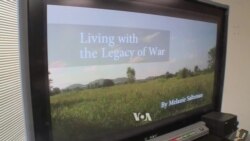There are nine new landmine victims around the world every day, according to the International Campaign to Ban Landmines. To help understand those numbers, a team of young reporters from a prestigious journalism school in Washington recently travelled all over the globe to investigate the problem.
Explosive remnants of war
Melanie Saltzman was one of those reporters. She recently travelled to Cambodia, a country with one of the highest number of landmines and unexploded ordnance. As a result, it also has one of the world's largest amputee populations and landmine casualties.
That’s why she wanted that assignment.
“I wanted to go there and meet people on the ground and see how survivors were affected," she said.
Armed with a video camera, she traveled to several provinces in the Southeast Asian country to focus on the human side of the landmine problem.
“I wanted to tell this story because I wanted to see what survivors go through on a daily basis long after landmines are gone, or long after accidents have happened,” she explained.
Living with legacy of war
Saltzman captured the stories of individuals who’ve sustained horrific injuries from landmine accidents in a short film, titled Living with the Legacy of War.
Working with an interpreter, she interviewed survivors like Tep Vy, a father of two young boys, who lost his leg when he stepped on a landmine on the Khmer-Thai border in 1993. She also met a traumatized 17-year-old girl who had lost her leg just one month earlier, who Saltzman described as simply “terrified.”
“Even once these things are out of the ground and gone, the survivors are still on the ground and they still need help and that's what I wanted to focus on,” the young filmmaker emphasized.
Victim assistance
Saltzman’s film also highlights efforts being made by the international community and aid agencies to help people like Tep Vy with free medical centers, hand-crafted prosthetics, and physical rehabilitation facilities where landmine victims can learn to use their artificial limbs in everyday life.
While most of the centers are being funded by NGOs and a few by the U.S. government, she pointed out that money is quickly dwindling.
Saltzman was part of a team of eight graduate students in the National Security Reporting Project, a three-month-long program at Medill.
It was established in January, 2009, to equip journalists with the knowledge and skills to report accurately and innovatively on issues related to defense, security and civil liberties, and to do so across all digital platforms.
The theme of the project this year was “Deadly Debris” — an investigation into the deadly legacy of landmines and cluster bombs around the world and Washington's $3.2 billion effort to remove them.
Project leader Josh Meyer said it is the fifth project in the series of annual investigative reporting efforts.
“Each year we pick a topic that we think is a real substantive topic for the students to tackle; something that's going to give us a good story one way or the other that will allow them to travel internationally," he explained. "And this year we picked landmines and cluster munitions, and what the U.S. government is doing to try to clean up the mess that it left essentially behind."
Dangerous assignments
In addition to Cambodia, students reported from Mozambique, Ukraine, Jordan and a still-active conflict zone in Iraq.
Matthew Schehl and his teammate Alexandra Hines traveled to Iraq to cover mine clearance operations in Kurdistan.
“The United States leads the world in the amount of money that we donate trying to help out,” Schehl said, “but at the same time there’s this big gap between the amount of ordnance that’s actually in the ground versus what we’re doing to clean it up.”
A veteran of Iraq and Afghanistan, Schehl said he was thrilled to be there.
“We've invested so much time researching this topic and to be out there in the field face-to-face with the people who are actually doing this work was magnificent,” he added.
Getting reporters like Schehl traveling to places like Iraq “is just a really cool experience for the students,” Meyer said. “And they really do learn things that you just can’t learn in a classroom. You really learn how to write the stories, how to do edit the videos, how to do it on a deadline.”
After an in-depth, three-month long investigation, the students found that while the U.S. is a world leader in landmine cleanup, there’s still much more that needs to be done to remove these deadly remnants of war.
Their findings were published on GlobalPost, an award-winning digital journalism site, and on a website they created specifically for their projects.
“By producing stories and by showing survivors and the needs that are still out there, and humanizing it, you hope that it will encourage not only people but also governments to stand up and do even more,” said Saltzman, summing up the students' goal.






